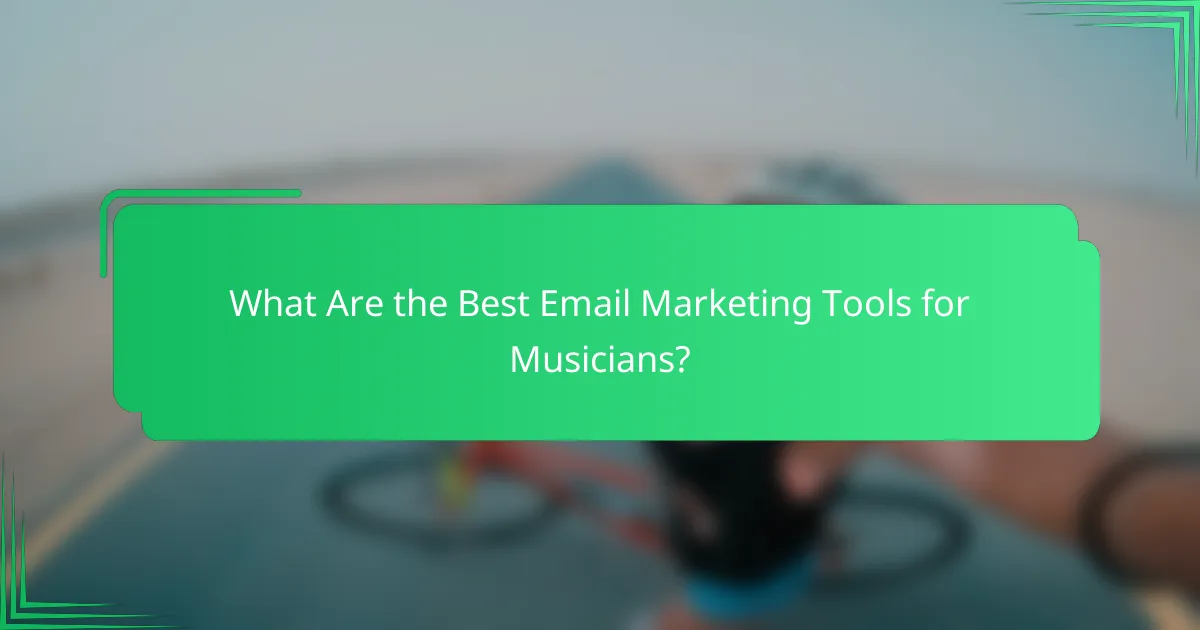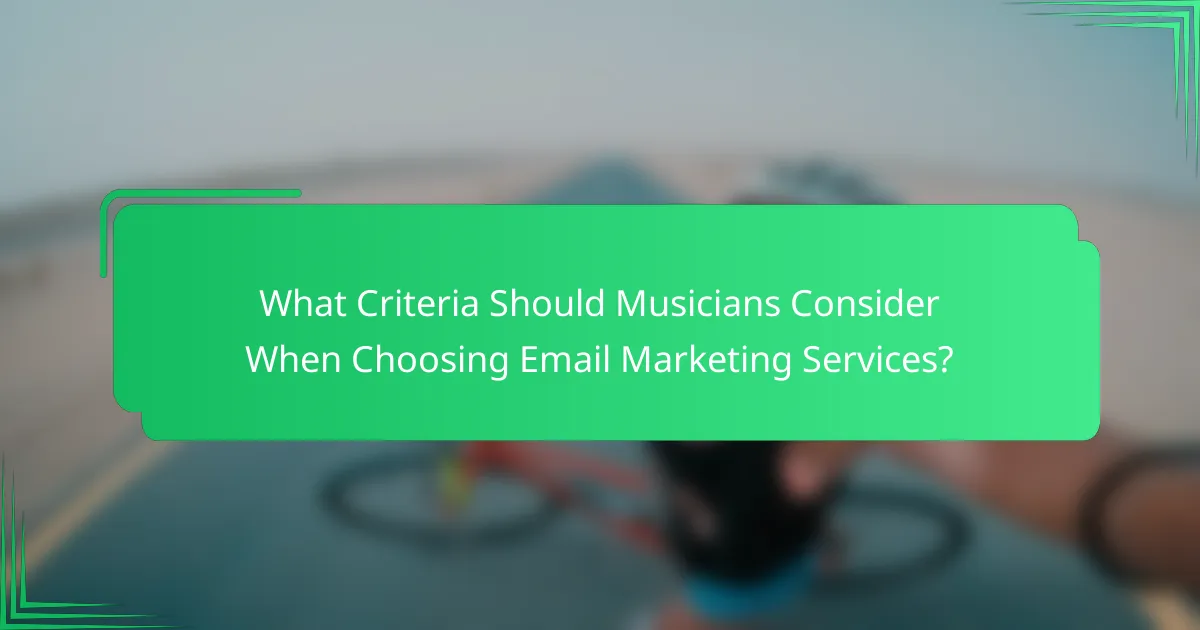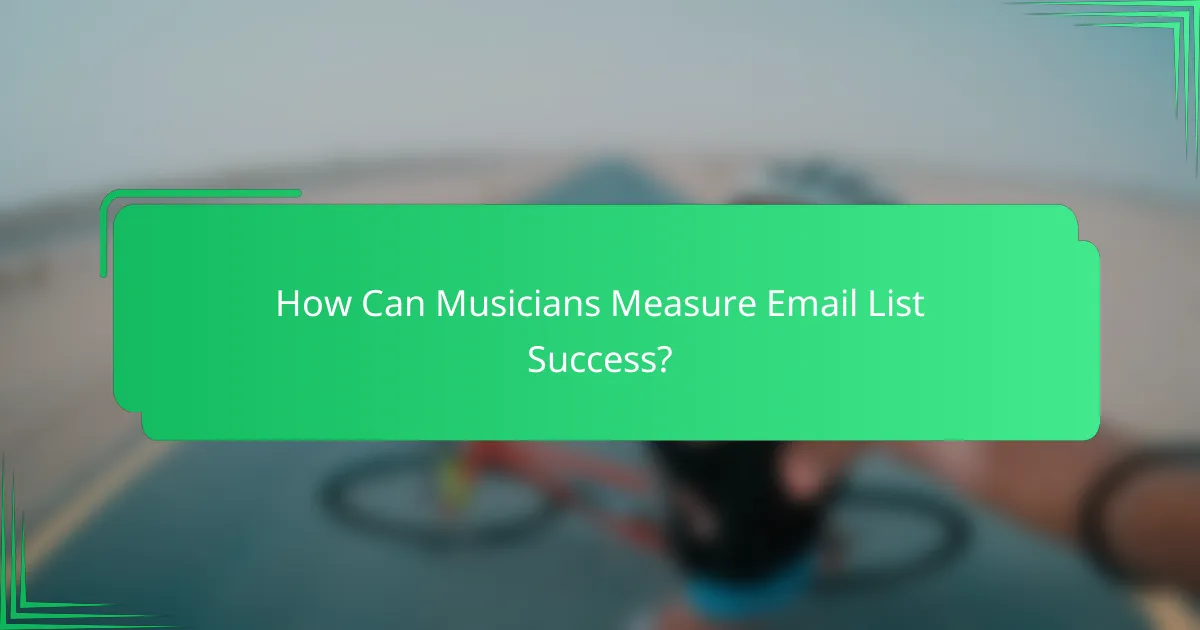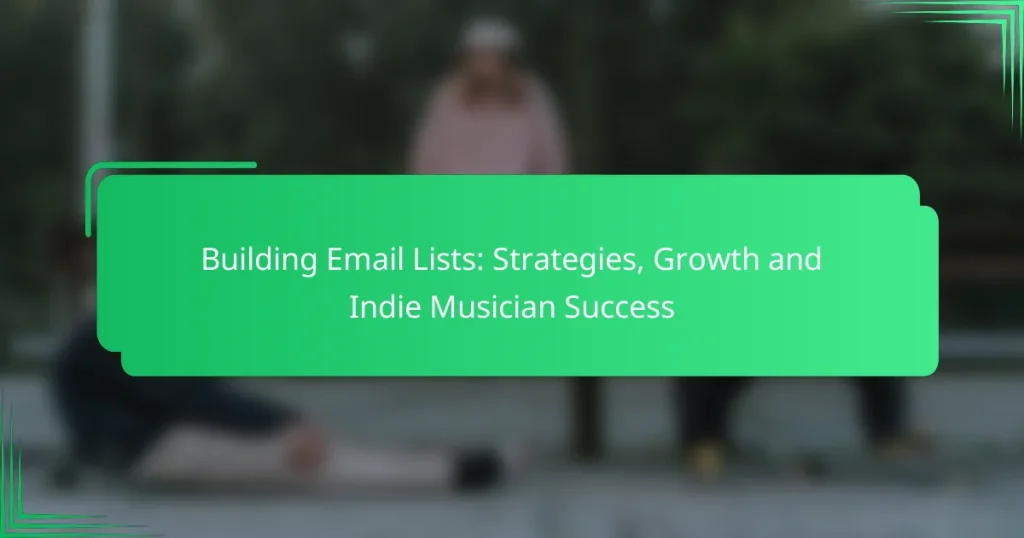Building a robust email list is essential for indie musicians looking to connect with their audience and foster loyalty. By implementing targeted strategies such as engaging content, exclusive offers, and collaborations, musicians can effectively grow their subscriber base. Choosing the right email marketing tools further enhances communication and engagement, paving the way for long-term success in the music industry.

How Can Indie Musicians Build Effective Email Lists?
Indie musicians can build effective email lists by leveraging various strategies that engage their audience and encourage sign-ups. Focusing on direct interaction, exclusive offerings, and collaboration can significantly enhance list growth and fan loyalty.
Utilizing social media platforms
Social media platforms are powerful tools for indie musicians to promote their email lists. By sharing engaging content and clear calls to action, artists can direct followers to sign up for their newsletters. Utilizing features like Instagram Stories or Facebook posts can create urgency and excitement around joining the email list.
Consider running targeted ads on platforms like Facebook or Instagram to reach a broader audience. These ads can highlight the benefits of joining the email list, such as exclusive updates or special offers, increasing the likelihood of conversions.
Offering exclusive content
Providing exclusive content is a compelling way to attract subscribers to your email list. This could include early access to new music, behind-the-scenes videos, or special merchandise discounts. By offering something unique, you create a strong incentive for fans to sign up.
Consider segmenting your email list based on interests, so you can tailor exclusive content to different groups. For example, fans who love live performances might appreciate exclusive concert footage, while others may prefer new song releases or personal updates.
Engaging with fans through live events
Live events are an excellent opportunity for indie musicians to engage with fans and promote their email lists. Whether it’s a concert, a meet-and-greet, or a virtual event, musicians can encourage attendees to sign up for their newsletters on-site. Providing a simple sign-up sheet or a digital form can streamline this process.
Additionally, offering incentives during events, such as a raffle for concert tickets or exclusive merchandise, can motivate fans to join your email list on the spot. This personal interaction helps build a stronger connection with your audience.
Implementing lead magnets
Lead magnets are valuable resources offered in exchange for email sign-ups. For indie musicians, this could be a free downloadable track, a discount on merchandise, or access to a private livestream. The key is to ensure that the lead magnet is appealing and relevant to your target audience.
When creating a lead magnet, focus on quality and uniqueness. A well-produced song or an engaging eBook about your music journey can attract more subscribers and enhance their connection to your brand.
Collaborating with other artists
Collaborating with other artists can expand your reach and help grow your email list. By partnering with musicians who have a similar fan base, you can cross-promote each other’s email lists. This strategy not only increases exposure but also builds community within the indie music scene.
Consider hosting joint events or creating collaborative content that encourages both fan bases to sign up for your newsletters. This approach can lead to a mutually beneficial relationship, enhancing visibility and engagement for all involved artists.

What Are the Best Email Marketing Tools for Musicians?
The best email marketing tools for musicians focus on automation, ease of use, and cost-effectiveness. Selecting the right platform can enhance audience engagement and streamline communication with fans.
Mailchimp for automation
Mailchimp is renowned for its robust automation features, allowing musicians to set up targeted campaigns that run on autopilot. You can create automated welcome emails for new subscribers or schedule newsletters to go out at optimal times.
Consider using Mailchimp’s segmentation tools to tailor your messages based on subscriber behavior, such as past concert attendance or merchandise purchases. This targeted approach can significantly increase engagement rates.
ConvertKit for creators
ConvertKit is designed specifically for creators, making it an excellent choice for musicians. Its user-friendly interface allows for easy creation of landing pages and sign-up forms, which are essential for growing your email list.
With ConvertKit, you can also utilize tagging and segmentation to send personalized content to different groups of fans, enhancing the overall fan experience. This feature is particularly useful for promoting specific events or releases.
Sendinblue for cost-effectiveness
Sendinblue stands out for its affordability, offering a free plan that includes essential features for email marketing. This makes it a great option for independent musicians on a budget who still want to maintain a professional presence.
In addition to email marketing, Sendinblue provides SMS marketing capabilities, allowing you to reach fans through multiple channels. This versatility can help boost your promotional efforts without breaking the bank.
AWeber for ease of use
AWeber is known for its straightforward setup and user-friendly design, making it ideal for musicians who may not be tech-savvy. The platform offers a variety of templates that can be customized to match your brand.
AWeber’s drag-and-drop email builder simplifies the process of creating visually appealing newsletters. Additionally, its extensive library of educational resources can help you maximize your email marketing strategy.

How Do Indie Musicians Grow Their Email Lists?
Indie musicians can effectively grow their email lists by employing targeted strategies that attract and engage their audience. These methods include running ad campaigns, creating appealing landing pages, utilizing content upgrades, and networking with industry influencers.
Running targeted ad campaigns
Targeted ad campaigns allow indie musicians to reach specific demographics likely to be interested in their music. By using platforms like Facebook and Instagram, artists can tailor their ads based on age, location, and musical preferences, ensuring their message reaches the right audience.
To maximize effectiveness, set a clear budget and monitor ad performance regularly. Consider A/B testing different ad creatives to see which resonates best with potential subscribers. A budget of around $50 to $200 can yield significant results if targeted correctly.
Creating engaging landing pages
An engaging landing page is crucial for converting visitors into email subscribers. It should clearly communicate the value of signing up, such as exclusive content, early access to music, or special offers. Use compelling visuals and concise copy to capture attention.
Incorporate a simple sign-up form and ensure the page is mobile-friendly. Tools like Leadpages or Unbounce can help create professional-looking landing pages without extensive technical skills. Aim for a conversion rate of at least 20% to gauge effectiveness.
Utilizing content upgrades
Content upgrades are valuable resources offered in exchange for email addresses, such as free downloads, exclusive tracks, or behind-the-scenes content. This strategy incentivizes potential fans to subscribe by providing something they find appealing.
To implement this, identify what your audience values most and create relevant content. For example, offering a free EP or a discount on merchandise can be effective. Promote these upgrades on social media and your website to attract sign-ups.
Networking with industry influencers
Networking with industry influencers can significantly boost your email list growth. Collaborating with musicians, bloggers, or podcasters who have an established audience can introduce your music to new fans.
Reach out to influencers for potential partnerships, guest appearances, or social media takeovers. Ensure that the influencers align with your brand and target audience for maximum impact. A well-placed mention can lead to a substantial increase in subscribers, so approach these relationships strategically.

What Criteria Should Musicians Consider When Choosing Email Marketing Services?
Musicians should evaluate email marketing services based on pricing, features, integration capabilities, and customer support. These criteria ensure that the chosen service aligns with their specific needs and budget while facilitating effective audience engagement.
Pricing and budget considerations
When selecting an email marketing service, pricing is a crucial factor. Many platforms offer tiered pricing based on the number of subscribers or emails sent, with costs typically ranging from $10 to $300 per month. Musicians should assess their budget and consider free trials to gauge the service’s value before committing.
Additionally, be aware of any hidden fees, such as charges for additional features or exceeding subscriber limits. Understanding the total cost of ownership will help avoid unexpected expenses.
Features and functionalities
Key features to look for include customizable templates, automation tools, and analytics capabilities. A good email marketing service should allow musicians to create visually appealing campaigns and automate follow-ups, saving time and enhancing engagement.
Consider whether the platform supports segmentation, which enables targeted messaging to different audience groups. This feature can significantly improve open and click-through rates, leading to better overall results.
Integration capabilities
Integration with other tools is essential for streamlining workflows. Check if the email marketing service easily connects with platforms like social media, websites, and customer relationship management (CRM) systems. This connectivity can enhance data collection and audience insights.
For instance, integrating with a music distribution service can help automatically add new fans to your email list, ensuring that your communications reach your growing audience without manual effort.
Customer support options
Reliable customer support is vital, especially for musicians who may not be tech-savvy. Look for services that offer multiple support channels, such as live chat, email, and phone support. A responsive support team can help resolve issues quickly, allowing musicians to focus on their craft.
Additionally, consider the availability of resources like tutorials, FAQs, and community forums. These can provide valuable assistance and help users maximize the features of the email marketing service.

How Can Musicians Measure Email List Success?
Musicians can measure email list success by tracking key performance indicators such as open rates and click-through rates. These metrics provide insights into audience engagement and the effectiveness of email campaigns.
Tracking open rates
Open rates indicate the percentage of subscribers who open an email. A typical open rate for the music industry ranges from 15% to 30%, depending on the artist’s engagement level and the quality of the email list. To improve open rates, consider crafting compelling subject lines and sending emails at optimal times.
Regularly monitor open rates to identify trends. If rates drop significantly, it may signal that your content is not resonating with your audience or that your list needs cleaning. Aim to maintain a healthy list by removing inactive subscribers periodically.
Analyzing click-through rates
Click-through rates (CTR) measure the percentage of subscribers who click on links within your emails. A good CTR in the music industry typically falls between 2% and 5%. To enhance CTR, ensure that your emails contain clear calls to action and engaging content that encourages interaction.
Evaluate which links receive the most clicks to understand what interests your audience. This analysis can guide future content creation and promotional strategies. Avoid overwhelming your subscribers with too many links, as this can dilute their focus and reduce overall engagement.


